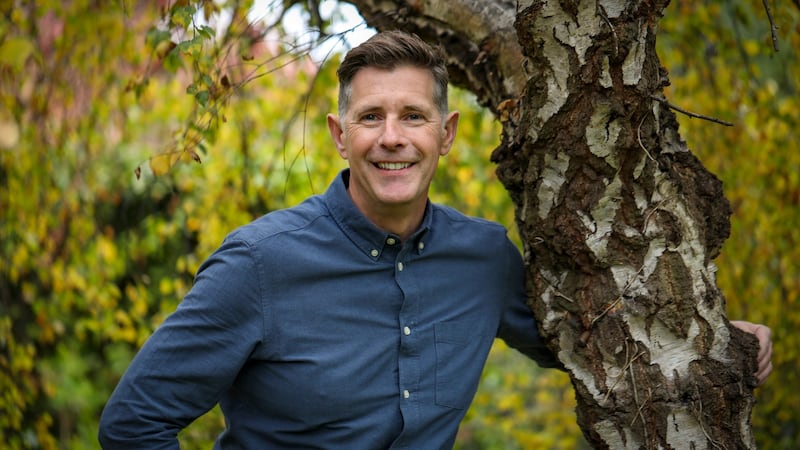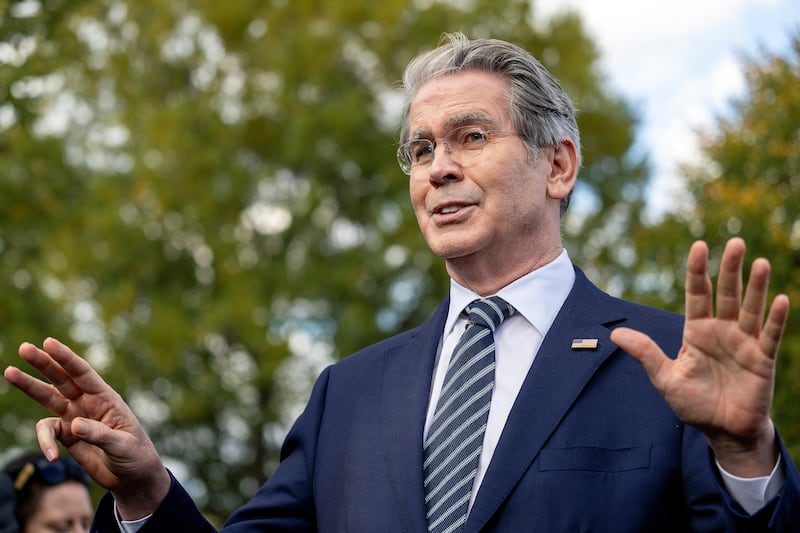A few days before the new pandemic restrictions, I go to sit in Dermot Bannon’s garden. I have written about his always-entertaining home makeover programme Room to Improve more than any other show, but we have never met in person before. When he texted me his address, I was going to text back “I know where you live”, but then thought better of it.
“That would have been a bit creepy, all right,” Bannon agrees when I arrive.
He's very good-humoured about my obsessive attempts to document his work. As is his wife Louise. "I do actually exist," she says pointedly when I meet her.
I had suggested in a previous column that she didn’t really exist. “You forget what you’ve written, don’t you?” says Bannon, laughing.
The reason Louise and their children (who also exist) are happy to stay out of the limelight is because almost everywhere Bannon goes, people whip out mobile phones and either take photos or show him extensions they want input on. And who needs that?
We sit at a table outside his sliding back doors in the “outdoor room” you’ll recognise from the last series. He notes that he hasn’t yet done the grouting on his garden steps because he has a tendency to procrastinate on his own projects when the cameras go off. “All the finer things, I’ve put on the long finger.”
When did he first want to be an architect? "I can't remember ever wanting to be anything else," he says. "My dad was a horticulturalist . . . My mum was a teacher, home economics. There were no architects in the family . . . But I was building stuff with Lego since I can remember. This is really sad, but Arnotts used to run Lego-building competitions. I used to go in and win. I think in the last competition I was too old for it but I lied about my age."
Did he win that year? “Yes.”
What did he build? “We’re going there, are we? I would have built buildings, but because there was so much Lego there you could build them as big as possible. It was like this Aladdin’s cave. You could requisition a big load for yourself. I could be in there for five hours. You’d leave it on a plinth with a card.”
Did he win a huge award, something Arnotts might demand back now I’ve exposed the scandal? “You won a book voucher or something like that. A fiver. It was more the honour of it.”

I could just lie to you and say I had no interest in the telly, that I just wanted to be a serious architect
His interest in buildings came from an interest in people. His family left Malahide for two years in Cairo when he was around six – his father was working there – and he remembered being fascinated by how the people there interacted with their environments. This interest extended to Irish towns. "At my Granny's home in Campile in Wexford there were pillars outside the church [and people] hung around the pillars like around a bar table."
He inherited a community spirit from his busy parents, spending weekends watering plants and cleaning streets for Malahide Tidy Towns (his father was very involved in this). After the Lego phase, he was more likely to be rubbing beeswax on old chairs he bought in a junk shop than playing sport.
When he eventually went to study architecture he was enthralled by everything from designing door handles to urban planning. Over the course of our chat he references inspirational architects such as Luigi Snozzi, Herman Herzberger and Group 91. He talks about a putative university campus he designed to run by the river in Kilkenny and still sounds enthused about it.
“It sounds utopian,” I say.
“It is,” he says.
The passionate utopian in Bannon comes across in Room to Improve and it's what makes it so enjoyable. The clash between his high-level vision and that of his less-aesthetically sophisticated clients can be very entertaining. He had previously been designing hospitals and schools but 14 years ago when he saw that Coco Productions were looking for a replacement for Roisin Murphy on House Hunters, he applied.
“I could just lie to you and say I had no interest in the telly, that I just wanted to be a serious architect, but then, why did I apply for it? I remember making the phone call thinking that I wasn’t that serious about doing it. But I was. There was something really intriguing about it. Room to Improve came the following year.”
The logic for Room to Improve at the time, he says, was that people were paying huge amounts of stamp duty on new houses, when they could have used the money to improve the ones they had. "RTÉ weren't convinced I could do it by myself," he says. "They weren't convinced I was a strong enough character. There were all these talks about a psychologist or life coaches . . . And I suppose I'm not a natural presenter. I'm not hosting. I'm not a 'ta-da!' with the jazz hands kind of person. I think the audience feel like they're dropping in on something that I'm involved in."
We discuss the Irish culture of extension-building and how Room to Improve fits into that. "We had a bit of a habit in Ireland of redecorating and putting on an extension just because there's a communion coming up," he laughs. "There's no other society that does that. And normally it plunges one room in the middle of the house into darkness. And they never use it, they just walk through to the new kitchen . . . Hopefully Room to Improve has shown that there's other ways to do things."
Irish tastes have changed, he says. I have joked in the past that Room to Improve is basically The Field without the Yank murder. He uses the analogy himself about Irish people and land. “It’s The Field,” he says. “First it was about owning a plot of land. And then it was about having a bigger plot of land.”
For a long time, he says, size was everything. Now, he says, people “want quality of space, as opposed to quantity of space. When I started off as an architect, it was all about ensuite bathrooms and conservatories. They had a list of spaces. But nobody ever described what the spaces were like. They just wanted to be able to say ‘I have a five-bedroom house, all ensuite’. I’ve learned far more from somebody describing a Saturday or a Tuesday to me about what they need, rather than ‘we need this and this’.”
But things have changed, he says. “Now people are saying, look, I’d love it to be filled with light. I’d like the rooms to be connected.” Lighting he jokingly refers to as “module one”. “I kind of think, ‘Have we done the light bit? Have we all got that?’”
Do they never say, ‘I would like it to be really dark’?
He laughs. “Those people go to the other architects. The dark architects.”
Does his desire to be seen as a good architect ever clash with the needs of good telly?

I never really missed [going out to] work. What's far more important is human connection, your friends, your family
“I remember I made a mistake in one of the first seasons about the size of a window,” he says. “I said it to nobody. All I could think was, ‘How am I going to sort this out. The window is wrong.’ And we were having lunch and I said, ‘I’m glad that bit’s over. It was terrifying. You know there’s a mistake?’ and the director said, ‘We’re going back to film that now.’ And I felt sickened and a little bit betrayed by the producers. But when I watched it back it made for really good television and I thought, ‘Okay, as long as it gets sorted, it’s okay to say you’ve made a mistake.’ In fact, people were glad I made the mistake because I got emails saying, ‘Oh the same thing happened to me.’”
A new production of Room to Improve is under way, though there's no air date as yet. In the meantime, he has created two episodes of Incredible Homes. This is usually a travelogue about the best international architecture. They managed to shoot an episode in Canada but then the restrictions stopped them filming an episode in Spain. So in the second episode, they ended up focusing on Irish houses. "And I really loved that episode." It's a bit different, he says. "Normally I'm trying to tell the story of its architecture, and its people and its climate and culture through its buildings. When it came to Ireland, there's no point in me saying, 'Oh, my God it's really wet here.'"
He went to see three beautiful houses, one designed by Niall McLaughlin who, if you’ve been watching Room to Improve, was the man who suggested to Bannon that big windows might be problematic, because Ireland gets dark in the evening. This inspired him to illuminate his garden with “downlighting”. He shows me the “downlighting” from where we’re sitting.
How has the pandemic changed his life? He’s stoical about how it’s affecting his business and says it has made him reconsider his work-life balance. “It’s made me think very much about time with the kids because I got lots of it and I realised how much I was missing out on”.
On cue, a child cycles by. “Have you got a helmet?” Bannon calls.
“Yeah,” says the helmet-less child.
“I meant on your head,” he calls after him.
His priorities shifted this year, he says. “I never really missed [going out to] work. What I really felt robbed of was all those times I said no to going out and sitting with friends in the pub or getting lunch . . . What’s far more important is human connection, your friends, your family.”
Bannon is a thoughtful man. I had to reschedule this interview because my father was in hospital and not only was he accommodating but he was kind and told me a little about when his late father was sick. Before I go, he offers to show me the cast-iron garden bath which I have lampooned in my television column. It’s at the end of his landscaped garden, near a lockdown-friendly firepit and it will be used in conjunction with the sauna that can be found in a stylish shed.
“I’m sorry I said it was like something old man Steptoe would have,” I say.
He laughs. “Ah, it is a bit.” It’s currently filled with deflated footballs.
We stand there for a moment. The dome of a nearby church can be seen through the trees and is lit up at night. "It's like being in the Vatican, " he says.
It is a bit.
Dermot Bannon’s Incredible Homes airs on Sunday 25th October at 9.30 pm on RTÉ One and on RTÉ Player.
















